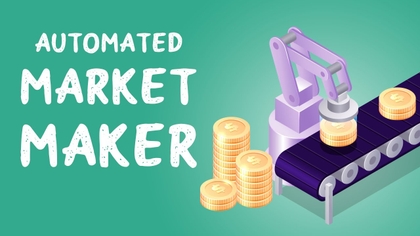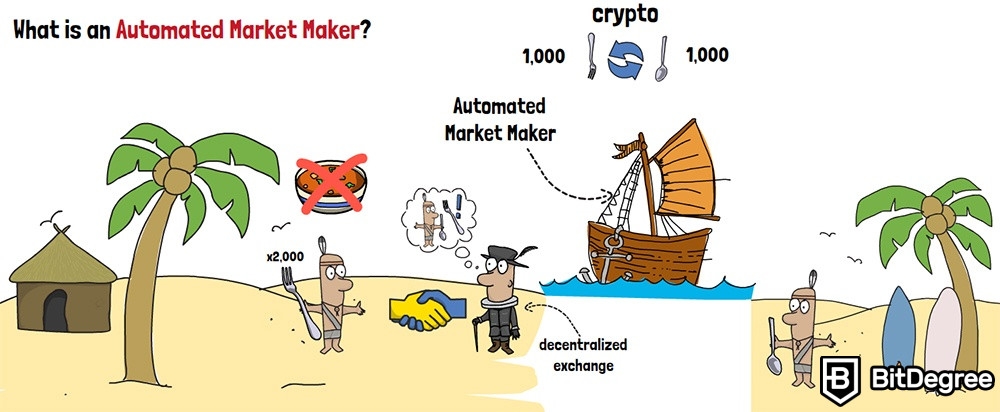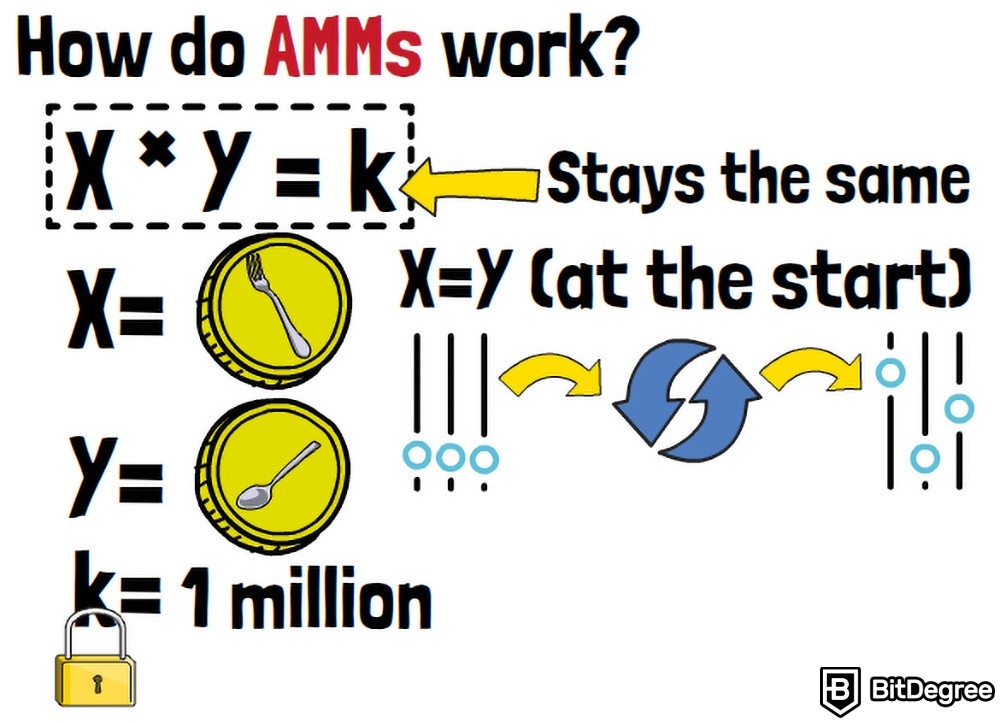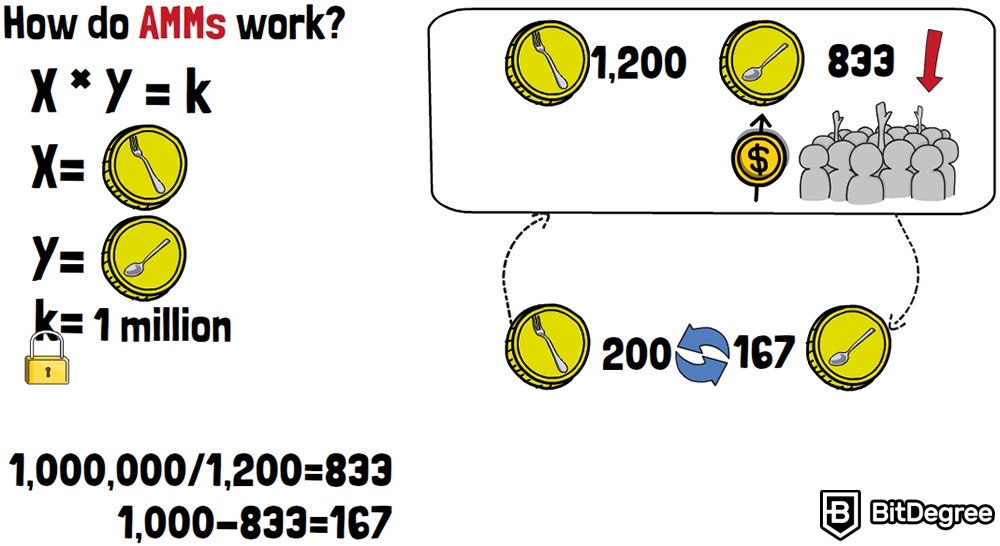6.10 Automated Market Maker: the Cornerstone of the Decentralized Crypto Exchange Industry
Stop overpaying - start transferring money with Ogvio. Sign up, invite friends & grab Rewards now! 🎁
In this section, we’re going to cover what is an Automated Market Maker!
Automated Market Makers, also known as AMMs - are special, complex algorithms that are designed to help people trade certain cryptocurrency assets with decentralized crypto exchanges. These algorithms react to the supply and demand factors automatically and allow traders to interact with them without needing another, real person to be present on the other side of a trade.
Automated Market Makers are also one of the cornerstones of the decentralized crypto exchange industry. Without AMMs, DEXs - the decentralized exchanges, wouldn’t really be able to exist and function, at least not in the way that they do now, and here I’ll explain why!
In this section, I will explain to you what an Automated Market Maker is, and how Automated Market Makers work!
Let’s get to it!

Video Explainer
Video Explainer: Automated Market Maker: the Cornerstone of the Decentralized Crypto Exchange Industry
Reading is not your thing? Watch the "Automated Market Maker: the Cornerstone of the Decentralized Crypto Exchange Industry" video explainer
What is an Automated Market Maker in Crypto? (Animated)


What is an Automated Market Maker?
So, it’s definitely no secret that Automated Market Making is one of the more-difficult topics in the cryptocurrency world. That’s mostly due to all of the technicalities surrounding it, as well as the fact that it’s covered with industry-specific jargon.
So, imagine that you live in a village, on an island, where everyone only uses forks, and no other eating utensils. Forks are great, but eating soup with them can be really difficult! With all of the abundance of forks that you have, other utensils would be great!

One day, a ship comes to visit your island. The captain of that ship tells you that he’s a businessman, and that he just left another island where the residents only had spoons. Coincidentally, the spoon-island residents would really love to have some forks at their disposal!
The captain proposes a deal to you - he will give you his ship that will travel between islands, and allow people to trade spoons and forks. All that this ship needs for this to work is an initial supply of utensils on both ends - say, 1000 forks, and 1000 spoons.
So to sum up, in the real world, the businessman from my story is the decentralized exchange, the ship is an Automated Market Maker and all of the goods that it transports are cryptocurrencies.
How do AMMs work?
Now, let’s stop right there. We’ll continue with the example moving forward, but allow me to first explain the premise of Automated Market Makers.
So, in our example, the forks and spoons would be two different cryptocurrencies - let’s call them FORK coin, and SPOON coin. The special ship that would travel between islands acts as the Automated Market Maker. So, essentially, in order for an AMM to function, you need to have two types of cryptocurrencies within it.
The catch here is that, when starting out, the Automated Market Maker should have an equal amount of both cryptocurrencies. I’ll explain why that’s the case soon, but essentially, that’s the way that the algorithm works.
So, with that cleared up, let’s get back to our example.
You agree to put 1000 forks into the special ship, while the residents of the other island agree to add 1000 spoons. All of these new utensils are stored on the special ship, but there’s a catch - the ship will keep your utensils arranged and tidy, but the value ratio for both the forks and the spoons must ALWAYS remain the same.

How would this be ensured? Simple - since there are 1000 forks and 1000 spoons on the ship, their joint value must always be 1 million. This value of goods is the result of multiplying the forks and the spoons.
What you’ve just witnessed is the core formula behind the Automated Market Making algorithm - in other words, it’s the essential rule that allows for AMMs to function properly! Written as a naked formula, it would look like this:
X * Y = k
Here, X is the forks, and Y is the spoons. The “k” stands for the result of the multiplication - a number that must ALWAYS remain the same in this equation, no matter what. In our example, it’s 1 million.
Why is this as important as it is? Well, take a closer look.
Say, you’ve noticed that there’s already a shortage of spoons on your island. You go to the special ship, and give it 200 forks. How many spoons would you receive back?
If you said 200, that’s actually wrong! The actual answer is 167. I know it may seem confusing, but check it out - it’s actually pretty simple!

The special ship has 1000 forks, and 1000 spoons on it. You want to give it more forks, in exchange for spoons. This means that there will be significantly fewer spoons than forks on the ship left, after the trade! This, in turn, makes the spoons more valuable, since there’s a higher demand for them!
How do you get 167? Well, first, you need to add your forks to the ship - that would total 1200 forks on deck. Then, you need to take the constant value number - 1 million -, and divide it by 1200. The result is 833. Now, simply subtract this number from the 1000 available spoons on the ship, and you get 167 - the number of spoons that you would get for your 200 forks!
Jumping back to Automated Market Making, this premise is very simple. As you trade the assets available on the AMM platform, the less of an asset that there is available to be traded, the more valuable and expensive it will become! So, if you want to give the Automated Market Maker your FORK coins in exchange for SPOON coins, and this trade would result in the number of SPOON coins plummeting on the platform, naturally, their price will increase.
Who or what exactly are you giving your coins to, and getting new coins from? Well, the “special ship” in our example has an even more special fuel tank - it’s actually called a “liquidity pool”.
If you know a few things about crypto, everything might have just clicked in your head. If not, and this term is completely new to you, I would highly recommend reading a dedicated section on liquidity pools, so as to get a better understanding of what this concept is.
Generally speaking, liquidity pools allow Automated Market Makers to function the way that they do. Within the pool, you’ll find two cryptocurrencies - in our case, those would be the FORK and SPOON coins.
As you interact and trade with the Automated Market Maker, it automatically checks to see what the situation is within the pool - in other words, whether or not certain coins are getting lower on supply, and higher on demand. If that’s the case, the AMM then adjusts the price for each cryptocurrency, according to the formula I mentioned earlier.
It should also be noted that all of these processes happen in a matter of milliseconds!
What’s very important to take away from all of this is the fact that an Automated Market Maker - or, more specifically, the liquidity pool that the AMM uses - needs to start with an equal amount of two assets, in order to establish the “k” value in our formula.
That’s because this value will then be used to calculate and recalculate the prices (or values) of the coins, each time that a transaction happens.
So, now that you know what an Automated Market Maker is, your next question might be - what is this tool even used for? Can’t people just trade with one another, without all of these complicated tools?
To tell you the truth, AMMs are an amazing invention, and they are essential in keeping places such as decentralized cryptocurrency exchanges alive and functional! Automated Market Makers allow people to trade their assets of choice, without a need for there to be another person that would be interested in performing that trade, at the same point in time. So basically, at decentralized exchanges, you, as a person, will trade with a machine, not with a human.
Imagine that you want to trade your Ethereum coins for some Bitcoin. Doing it the old-fashioned way, you would need to wait for someone else who would want to trade their BTC for ETH, and if all of the parameters of the trade match, you would be able to perform that trade.
When we use Ethereum and Bitcoin as examples, it might seem almost comical. However, don’t forget that there are plenty of far less-known crypto assets out there, on the market! This means that you could be waiting for someone to match your trade for a long amount of time.

Not an issue with Automated Market Makers, however. With these tools on decentralized exchanges, you can perform your trades instantly!
On another point, liquidity pools are also a method of how cryptocurrency enthusiasts are able to earn a passive income, too! Other sections cover staking and liquidity pools, so make sure to check those out - however, let’s go over the general premise here.
If you remember the beginning of the section, at the start of my example, I mentioned that 1000 forks and 1000 spoons are needed in order for the special ship to start working. Well, someone needs to supply all of those forks and spoons - in other words, someone needs to bring their cryptocurrencies to the liquidity pools. This doesn’t just happen out of thin air!

The people that supply these crypto assets are called liquidity providers, or simply - investors. The way how Automated Market Makers work is by rewarding the investors with a small percentage of coins, from each transaction happening in the pool. This way, with time, investors are able to make a profit, while crypto traders are able to trade coins that they want, with the Automated Market Makers!
Conclusion
It’s worth emphasizing that this is just the very general premise of how Automated Market Makers work. Nowadays, these algorithms are becoming more complex, and the more time you spend studying them, the more questions they will raise!
Just think about it this way - in this section, this Automated Market Maker example included two cryptocurrencies. Well, what if the AMM works with not two, but three, four, five, or more crypto assets all at once? Then, the formula becomes even more intricate!
So, we've come to an end, I do hope that you’ve learned a lot! If you would like to learn more about the world of crypto check out the section about Web 3.0!










